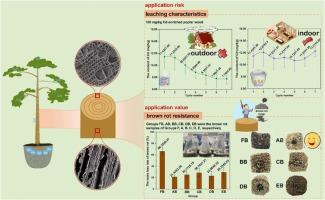Application risk and value of Cd-enriched poplar wood: Wood properties, leaching characteristics and brown rot resistance
IF 12.2
1区 环境科学与生态学
Q1 ENGINEERING, ENVIRONMENTAL
引用次数: 0
Abstract
This study investigated the application risk and value of Cd-enriched poplar wood, focusing on its wood properties, leaching characteristics, and brown rot resistance. The results indicated that Cd deposition in cell walls significantly inhibited brown rot fungi, thereby enhancing decay resistance. Furthermore, the extent of improvement in brown rot resistance was linked to wood density: the higher the density of Cd-enriched poplar wood, the stronger its resistance to brown rot. As the Cd concentration increased, the Cd distribution abundance and the wood crystallinity gradually increased. Structural changes were observed, including fluctuating microfibril angle and double wall thickness of fibers and vessels. Cd concentrations exceeding 50 mg/kg altered the chemical composition of the cell walls. The binding form of Cd in wood cell wall showed a trend of bound Cd > free Cd > residual Cd. Cd leaching occurred under cyclic soaking in water, which may lead to secondary contamination. However, under the condition of 75 % relative humidity, Cd leaching was negligible, suggesting potential for safer use in controlled environments. These findings provide valuable insights into the management and application of Cd-enriched wood, especially in contexts where decay resistance is critical or in water-exposed environments.

富含镉的杨木的应用风险和价值:木材特性、浸出特性和抗褐腐病能力
本研究调查了富镉杨木的应用风险和价值,重点关注其木材特性、浸出特性和抗褐腐性。结果表明,镉沉积在细胞壁中能显著抑制褐腐真菌,从而增强抗腐烂性。此外,抗褐腐病能力的提高程度与木材密度有关:富含镉的杨木密度越高,抗褐腐病能力越强。随着镉浓度的增加,镉分布丰度和木材结晶度也逐渐增加。观察到的结构变化包括纤维和血管的微纤维角和双壁厚度的波动。镉浓度超过 50 毫克/千克会改变细胞壁的化学成分。镉在木材细胞壁中的结合形式呈现出结合镉 > 游离镉 > 残余镉的趋势。镉在水中循环浸泡时会发生浸出,这可能会导致二次污染。不过,在相对湿度为 75% 的条件下,镉的沥滤几乎可以忽略不计,这表明在受控环境中使用镉具有更安全的潜力。这些发现为富镉木材的管理和应用提供了有价值的启示,尤其是在对抗腐蚀性能要求很高的情况下或在暴露于水的环境中。
本文章由计算机程序翻译,如有差异,请以英文原文为准。
求助全文
约1分钟内获得全文
求助全文
来源期刊

Journal of Hazardous Materials
工程技术-工程:环境
CiteScore
25.40
自引率
5.90%
发文量
3059
审稿时长
58 days
期刊介绍:
The Journal of Hazardous Materials serves as a global platform for promoting cutting-edge research in the field of Environmental Science and Engineering. Our publication features a wide range of articles, including full-length research papers, review articles, and perspectives, with the aim of enhancing our understanding of the dangers and risks associated with various materials concerning public health and the environment. It is important to note that the term "environmental contaminants" refers specifically to substances that pose hazardous effects through contamination, while excluding those that do not have such impacts on the environment or human health. Moreover, we emphasize the distinction between wastes and hazardous materials in order to provide further clarity on the scope of the journal. We have a keen interest in exploring specific compounds and microbial agents that have adverse effects on the environment.
 求助内容:
求助内容: 应助结果提醒方式:
应助结果提醒方式:


